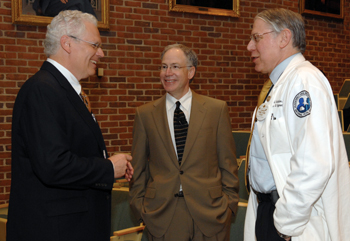
Allan Brandt, Ph.D., of Harvard University, center, talks with Larry Churchill, Ph.D., left, and Steven Gabbe, M.D., before last week's Discovery Lecture. (photo by Dana Johnson)
Lecturer lights up debate on smoking industry’s marketing
Forget Central Park, the Statue of Liberty, and the Metropolitan Museum of Art. On his first visit to New York City as a 7-year-old, Allan Brandt, Ph.D., wanted only to see Times Square's most prominent billboard — a giant ad for Camel cigarettes that blew steam “smoke” rings out of the face of the board.
He wanted to see in person what he'd first seen in a children's book.
“Even as a 7-year-old, I knew smoking was dangerous,” said Brandt, professor of the History of Medicine at Harvard Medical School. “The billboard represented a paradox — how can something so great, so remarkable, so public, be promoting something that I had already learned was so profoundly bad?”
He didn't know then that he would dedicate part of his academic career to investigating how the shrewd and deceptive machinations of the tobacco industry drove the cigarette market in the United States.
He has compiled his years of research into the award-winning book, “The Cigarette Century: The Rise, Fall, and Deadly Persistence of the Product that Defined America.” Brandt also testified as an expert witness in the 2004 U.S. v. Philip Morris case, the racketeering case brought by the federal government against the tobacco industry.
“The cigarette represented so many important aspects not only of health and disease, but culture, business, technology and the law, that I realized I had a long-standing interest in trying to explore the problems associated with tobacco use in more detail,” he explained.
In his talk, Brandt outlined several questions that have driven his research: how smoking became so popular; how we know smoking is dangerous; the role of the state in regulating things that are proven harmful; the nature of corporate and individual responsibility for harms incurred by smoking; and the implications of globalization for the tobacco pandemic.
In the early 1900s, cigarettes made up only 2 percent of tobacco use in the country. By 1952, 81 percent of all tobacco consumed in the United States was in the form of the cigarette.
But smoking is now declining in the United States, so the tobacco industry has shifted its focus to overseas markets, Brandt said.
“If educated individuals in western developed countries were dying or quitting smoking, they needed to search for replacement smokers, and the best place to look was in poorer, developing-world countries,” he noted.
This globalization will no doubt perpetuate and intensify the “tobacco pandemic.”
“About 100 million people died of tobacco-related diseases over the course of the 20th century,” Brandt said.
“It's now projected that a billion people will die in the 21st century of tobacco-related diseases even if smoking rates just stayed right where they are today.”
“This confronts us with one of the great moral and ethical questions of contemporary medicine and public health: what does this say about our capacity to reduce a pandemic when we understand the scientific issues so completely and explicitly as we do in the instance of cigarette smoking?”
For a complete schedule of the Discovery Lecture Series and archived video of previous lectures, go to www.mc.vanderbilt.edu/discoveryseries.













